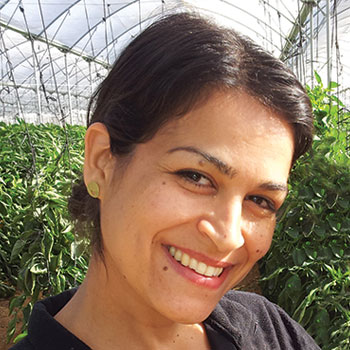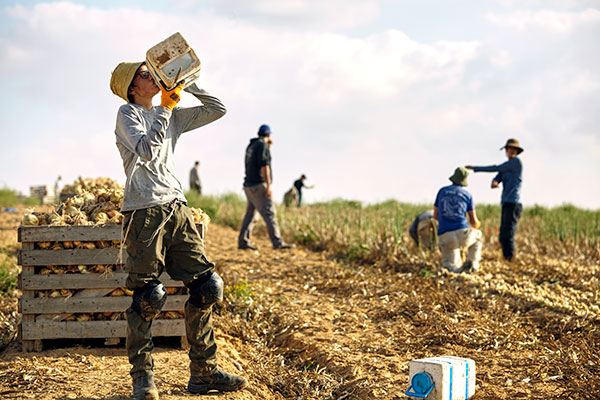By Celia Theller
Located in Israel’s southern Negev Desert, the Arava region receives approximately one inch (30 mm) of yearly rainfall. In comparison, cities like London and Melbourne receive around 24 inches, with New York receiving upwards of 45 inches annually.

Halutza farmers cultivate once-barren soil
“In the Arava,” noted local resident and the region’s Resource Development Director, Noa Zer, “all things water-related are challenging and farmers contend with limited brackish aquifer water three times as salty as tap water.”
Due to the lack of rain, all water for domestic use must be desalinated, which affects its price and availability. This is a major concern for farmers, especially since the Arava produces a large percentage of Israel’s fresh produce, including dates, their largest and most profitable export.
In addition to the water desalination systems provided by Jewish National Fund-USA, the organization is also leveraging its portfolio of Research & Development initiatives to teach farmers how to grow crops with “the worst water imaginable,” according to Zer, through efficient water use and water management projects.

Noa Zer
“If you would show European farmers the salinity level of our water in the
Arava, they would say ‘you can’t grow anything here’,” explained Zer. “Yet we manage to grow some of the best produce in the world!”
Gaza Evacuees Bring a Pioneering Spirit to the Waterless Desert
Following the 2005 Israeli disengagement from Gaza, a group of evacuee families chose to remain in the Negev desert in a remote corner that had never been farmed before.
For them, development of the Negev was Israel's next national mission as they strove to make the desert bloom.
Located in the northwest Negev on Israel's borders with Egypt, the 500 families created several agricultural communities known collectively as “Halutza.” And although the families feel a deep connection to their land, the one thing they’re not connected to is Israel’s national water grid.

A farmer takes a break while working the fields of Halutza
"Our group of communities live in a very dry area," said Halutza leader, Yedidya Harush. "We only get about three inches of rainfall a year. That is nothing. And as an agricultural community, we desperately need water."
Despite the low annual rainfall, Halutza’s farmers have been able to cultivate over 80 different species of fruits and vegetables.
The communities of Halutza depend mainly on costly desalinated water, making the agricultural yields less profitable. However, when Halutza farmers approached Jewish National Fund-USA, the organization saw an opportunity to deploy its philanthropic investments strategically that would attract more residents to the region.
In partnership with local farmers, the organization is working on a two-phase research and drilling project that will provide the region with good-quality water at a much lower cost.
"We were looking for a solution to help us with our water situation,” said Harush. “We understand that we can't continue to pay crazy amounts for water. Agriculture is not a romance. It is a business that needs to be economical to be competitive in the market.”
“The drilling project is crucial for developing the area’s agriculture, as it will provide farmers with affordable water,” he said.
“We drill for water, not oil.”
Cutting-edge practical research has proven critical for efficient water usage. Successes thus far include the Shamir Drills—the largest natural underground water resource of the past decade in Israel; the Hula Basin, which is a vital component of Israel's natural water economy; the Besor River Basin Rehabilitation; and the Multi-Year Water Allocation System (MYWAS), a national water management model designed to achieve the most efficient water resource management possible.

Housing sites continue to be created throughout Halutza's communities
"While other countries drill for oil, we drill for water, which is far more precious for us," Harush said. "Today Jewish National Fund-USA is our main partner in everything we do, and they are helping us achieve our dreams.”
While the first Halutza drilling exploration yielded water from a section of an underground river, it did not uncover the main water source, Harush explained. As they prepare for the second and third drilling rounds, plans are in the works to create a pond at the first drilling location to provide a drinkable water source for local wild animals and a recreational spot for hikers.
The project takes into consideration environmental protection and sustainability, Harush emphasized, and is conducted in consultation with top hydrological professionals.
"First and foremost, we consider the environment," he said. "We never want to cause environmental damage. We must live in synergy with nature. We have not come in place of nature.”
As the United Nations marks World Water Day on March 22nd, communities around the world look to Israel for innovations in water and sustainable agriculture. As the world leader in water recycling, Israel continues to share its achievements with other countries, even those without diplomatic relations.
For more information, visit jnf.org/water.
